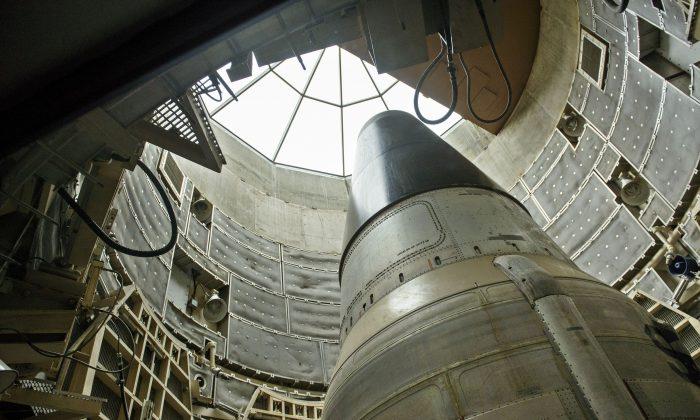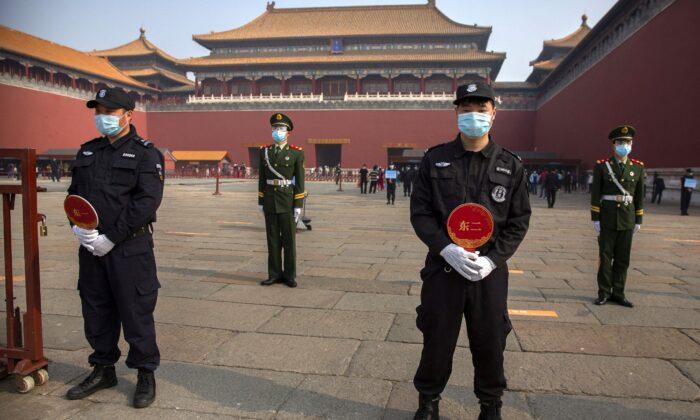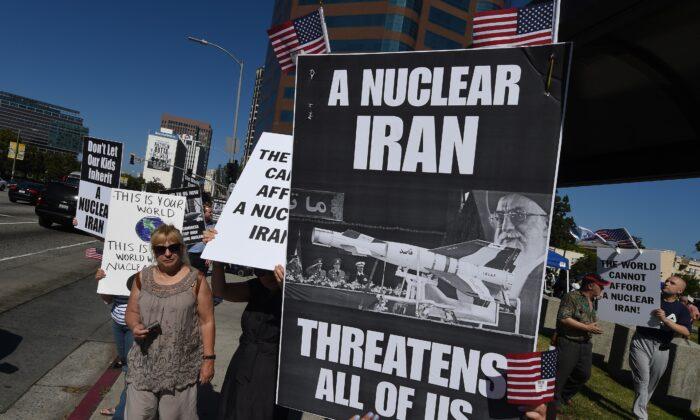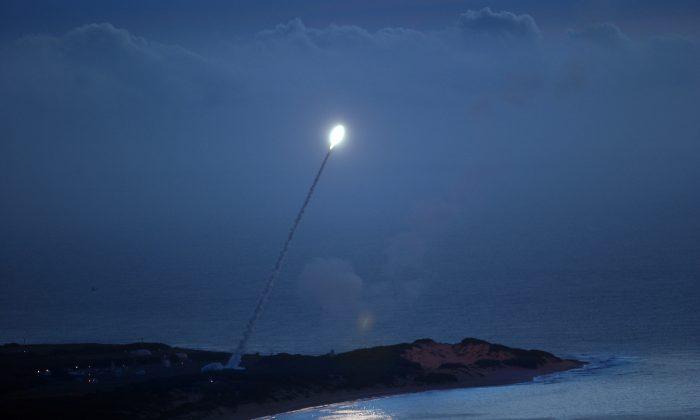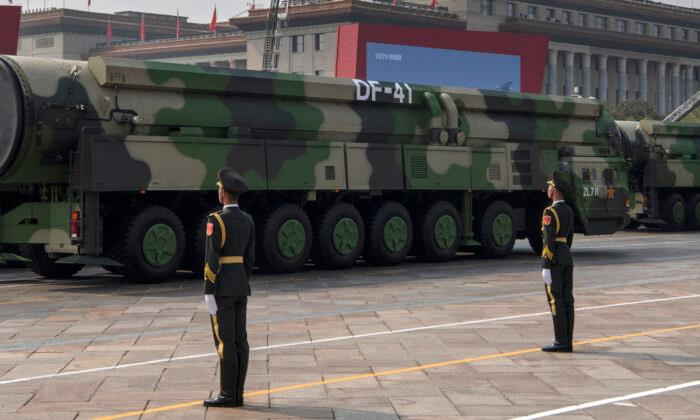During the Reagan administration, the fight over nuclear spending was one of a number of big defense conflicts, the others being missile defense (SDI) and assistance to governments and democratic resistance groups in Central America.
As Yankee great Yogi Berra once said, “It’s déjà vu all over again” and indeed it is. Emerging now after relative calm on nuclear spending, the 2019 change in the House leadership is threatening to unravel the spending consensus created over the past decade on nuclear modernization.
In late 2010, as the Senate was considering approving the New Start nuclear treaty with Russia, the Senate leadership, particularly Senator Jon Kyl, secured a commitment from the Obama administration to fully fund strategic nuclear modernization, including missiles, bombers, submarines, and associated warheads, along with the necessary command and control upgrades, in return for the Senate agreeing to the New Start Treaty.
Dangerous Directions?
Despite the Trump administration putting forward nearly the same nuclear deterrent modernization plan as the previous administration, with perhaps an admitted greater sense of urgency, and despite very strong bipartisan votes in 2017-2018 in favor of these modernization plans, the new House has decided to go toward a markedly more radical direction.This involves four big changes to the Obama/Trump plans.
First, despite not being able to produce new nuclear cores or pits for our warheads, the previously agreed to goal or requirement of producing 80 pits a year by the end of the next decade is abolished and reduced to 30.
Second, the new land-based missile—the ground based strategic deterrent (GBSD)—is significantly delayed, although the proposal of continuing the 50-year-old Minuteman missile for another 30 years was turned back.
The House—to date—has cut $108 million in GBSD funds and thus denied the Department of Defense a timely ability to go forward with previously agreed GBSD modernization of our land base missiles, although a proposal scheduled during House floor consideration of the NDAA to cut GBSD funding further was shelved.
Prior to floor consideration, during markup of the defense bill, the HASC was ready to put an ICBM cart—the current but aging MM III—before the alternative—an ICBM horse report. The Committee wanted to slow down GBSD but do so before they even knew the conclusions of a new report looking at alternatives such as whether it made more sense to proceed with the GBSD as planned or seek an alternative. The majority appeared to believe that an extended Minuteman could be built with some kind of reusable missile—what they termed a non-destructive test program—so they would not have to cannibalize the missile force in order to continue required testing of five missiles a year.
There is a big problem, however, with such an assumption. The current Minuteman missile rocket engines would have to be completely rebuilt to have such a capability. Today, such re-useable rockets such as those built by Elon Musk are liquid fueled rockets which need to be fueled before going on alert and are also unstable, as the 1984 Titan ICBM explosion proved. No ICBM the United States deploys now is liquid fueled and would not be in the future. The cost of rebuilding all the MM III missiles to be liquid fueled and able to be used would be in the multiple tens of billions in addition to all the other costs of a service life extension program.
But even more baffling was that the HASC leadership wanted such a new report despite nearly a dozen already completed reports by previous administrations including the Obama administration that a GBSD modernized missile, command and control system, and associated silos would be dramatically cheaper to build, more capable once deployed, and significantly more efficient to operate than any alternative.
This point has also been made repeatedly by America’s most senior military leaders, especially by General John Hyten, commander of our United States Strategic Command. Armed with such evidence, Representative Liz Cheney argued in the HASC markup that the proposed ICBM alternative study was redundant, with the result that the report requirement was deleted. Fortunately, when the bill reached the House floor the report requirement was resurrected but by a vote of 164-264—the amendment to do so failed.
Third, the House is also seeking a report on the strategic impact of adopting a “nuclear no first use” strategy, which no American administration has ever adopted in all of the 70 years of the nuclear age.
During the Obama administration, the Nuclear Posture Review contained very strong language opposing such a strategy and explained a no-first use strategy was particularly opposed by our allies in Europe and Asia, all of whom depended upon our robust and credible nuclear umbrella to protect their security from other hostile powers.
A top nuclear official in previous Democratic administration, John Harvey, spoke to this issue recently:
“Supporters of no first use are taken with the simplicity of the idea and its potential for bolstering U.S. moral leadership in the world. After all, they argue, the U.S. has no intention of starting a nuclear war, so why don’t we just say so? At the same time, this president and his NPR, and the four presidents who preceded him, have reviewed and rejected such a policy in light of associated risks to deterrence, to the assurance of allies, and to U.S. nonproliferation goals.”
And fourth and finally, the House seeks to ban the deployment of a small number of low-yield warhead variants on the D-5 submarine launched ballistic missile, designed to replace larger warheads but keep U.S. nuclear forces strictly at the New Start Treaty level.
This warhead proposal was a Trump administration initiative but is a counter deployment to Russia’s long-standing deployments of such weapons and an announced Russian strategy in 2000 that seeks to use such nuclear weapons in a limited way but early and first in a conventional conflict.
Unilateral Action
Like the opposition to the Reagan era nuclear modernization, advocates today are also pushing these anti-nuclear plans as unilateral actions by the United States requiring no reciprocal Russian action. In fact, these unilateral concessions and cuts are being proposed even as Russian modernization plans are to the point where Russia now has the capability if unconstrained to put into the field strategic nuclear warheads some 300 percent of the current U.S. force.Prospects for Resolution?
None of these proposed House actions, make sense. Instead, we should return to the Obama-Trump era of nuclear consensus where the 2010 and 2018 Nuclear Posture Reviews both agreed to fully fund nuclear modernization including our land-based missiles and warhead production facilities, and strongly rejected risky strategies of no first use or minimal deterrence, both strategies of far less credibility and deterrent effect than required by the second nuclear age we are now facing.Much of these issues will be resolved in the conference between the House and the Senate. And as the chairman of the HASC admitted during consideration of the NDAA, he did not have the votes to sustain such cuts into law as the Senate majority and the administration both oppose them. And just recently, the administration formally concluded in a formal Statement of Policy letter, that such nuclear program cuts in the House defense bill could very well compel a veto of the defense bill.
However, should the House insist on such cuts and delay the defense bill altogether, it might very well represent the third time since 1970 when Washington adopted a highly flawed nuclear “narrative” to justify unilateral cuts to our nuclear deterrent forces.
Having done unilateral cuts twice, we had very bad results. The 1970’s saw a neglect of defense by the United States and its allies leading to a “hollow army,” while the correlation of forces turned very decidedly against the United States and its allies where we also saw some two dozen nations fall to revolution and civil war and become enemies of the United States, often allied with the Soviet Union.
In the 1990s after the Cold War ended, we also neglected our nuclear deterrent and watched the rise of a newly authoritarian and well-armed Russia and China, along with Islamic jihad. It is true that now for nearly the past decade, since December 2010, the past two administration’s and the Congress have firmly supported the modernization of our nuclear deterrent. Each leg of the nuclear Triad is scheduled to be fully replaced starting at the end of the next decade.
As noted above, we have tried this twice before. The détente of the 1970’s was indeed a policy of appeasement—however inadvertent—that the Soviets took advantage of. In fact, during Carter’s one term as President, the B-1 bomber was repeatedly cancelled, the Ohio class submarine was delayed, the new land based ICBM “MX” missile acquisition was never funded as a mobile basing mode for the missile could not be agreed upon, while funds for the ground launched cruise and Pershing missiles promised for deployment in Europe were never put in the U.S. defense budget for acquisition.
All in all, the Soviets produced and deployed nearly two dozen key nuclear assets during the decade of détente while the United States successfully deployed simply a multiple warhead land-based ICBM, the Minuteman III missile and in part the new multiple warhead Poseidon missile on some of our sea-based deterrent.
Getting Back to Agreement?
Now we also know that even though every nuclear posture review since the end of the Cold War has strongly endorsed the need for a Triad, including a land-based ICBM leg of the Triad, the House, apparently now enamored with the global zero narrative, keeps pushing the United States toward delaying and possibly eliminating—unilaterally—this valuable Triad element as well as stopping the modification of the D-5 missile for deployment in the new Columbia-class submarine, and stopping the production of the warhead for the new bomber cruise missile.In short, each leg of the Triad would be delayed or eliminated, under the fanciful idea that U.S. restraint will somehow engineer similar restraint among our adversaries.
Has this worked before?
Representative Mike Turner explained during a March 6 HASC hearing, while the United States has cut its deployed or in the field nuclear weapons by 75 percent since 2001, (and 90 percent since 1991), China, Pakistan, India, and North Korea have expanded their nuclear forces, apparently oblivious to the good moral example set by the United States.
Unfortunately, while the Soviet Union and now Russia have reduced their long-range deployed nuclear forces under three treaties—START I, Moscow and the New START agreements—Russia’s shorter-range nuclear weapons have dramatically expanded as well as certain strategic long-range systems not captured by the terms of the current 2010 New START treaty between Russia and the United States.
Well, reply supporters of unilateral action, even if past unilateral cuts have not worked out well, we need to constrain the nuclear forces we have now because the administration is “against arms control.” And apparently without an effusive commitment to arms control by the administration, the House cannot support nuclear modernization, no matter how important or necessary.
In short, the House is going to “punish” the administration for not supporting “arms control.” In this case, the continued adherence to the INF treaty is at issue. In House floor debate on July 11, in a 215-214 vote, proponents argued successfully that the United States should still be bound by the INF treaty despite there no longer being two parties to the agreement.
In reality, once the Russian violations of the 1987 INF treaty became too serious to ignore, and when the United States and our NATO partners unsuccessfully called the Russians to account, such a declaration of finding Russia in serial violation of the INF treaty was required.
And this the administration did.
How this action morphed by administration critics into an animus against all arms control treaties is without any rationale. A new NATO study however has concluded that the administration is correct. NATO said, “At some point in the mid to late 2000s, the Russian Government decided to develop and later deploy a missile system—the SSC-8—which clearly violated the Treaty.”
And despite these major Russian violations concluded NATO, “Successive U.S. administrations over a number of years have sought to bring Russia back into compliance, but each attempt has been met with flat denial and total intransigence.”
The United States has thus announced—correctly—that it can no longer be bound by a treaty the Russians have abandoned, and here NATO “…has now come to a unanimous view in support of the U.S. analysis and its determination to confront the issue.
Whilst at every point a diplomatic solution had been and continues to be sought, an essentially bilateral Treaty that has been rendered inoperative by its violation by one party (Russia) should now be saved at any cost, even requiring unilateral U.S. adherence to a non-existing treaty!
As the British explain, “International arms control relies on adherence to reciprocal obligations and nations should not be required to subject themselves to unilateral observance of them. Arms control more generally is undermined by violation going unchallenged.
”It is not as if the United States has been a laggard on arms control. In fact, since 1981, the Reagan revolution in arms control achieved what many critics at the time said was impossible a marked and huge decline in strategic nuclear deployed forces by the United States and the then Soviet Union, (then Russia).
The very large cuts in nuclear weapons already achieved by the United States were started by President Reagan who at his very first press conference in 1981 reiterated his opposition to the SALT treaties that allowed for the huge buildup in Soviet and American nuclear weapons.
Arms Control Framework Needs Fixing
But arms control is neither sufficient to protect our security nor without serious flaws. The current remaining framework for arms control has serious problems that need correcting. The New Start treaty leaves the Russians with very large pathways to grow to 4500-5500 long range strategic nuclear warheads, to say nothing of Russia’s uncontrolled theater nuclear weapons that number at least an additional 2000 warheads.And the current framework also leaves China out of the picture, free as it is to deploy its own nuclear weapons but also to continue its long-term policy of proliferating nuclear weapons technology to its friends in the poor parts of the world, as it has with Pakistan, North Korea, Iran, Iraq and Libya.
Now the American administration has declared the New Start treaty can be extended but such action must be based on Russian treaty compliance, and it should include bringing China into a treaty arrangement and deal with Russian theater and strategic nuclear systems not now controlled.
On that score, a newly released British assessment backs up the Trump administration. As the British just announced, “there are no straightforward options for saving the INF Treaty in its current form and any attempt to replace it must be underpinned by robust and continuing verification requirements.
However, and this is key, a change in Russia’s policy on adherence to such agreements “would be a necessary prerequisite.” Secretary of State Pompeo met recently with the Russians to “negotiate new arms control accords that reflect current conditions and to bring in other nations, notably China.”
But that would still reward China for “playing hard to get” writes Aaron Kliegman. He correctly notes China in 1981 pledged to join arms control once the United States reduced its nuclear arsenal by 50 percent. The United States did reduce its deployed strategic systems by 50 percent, but China moved the goal posts claiming the United States had to get rid of more weapons.
When the United States got rid of another 70 percent of its weapons under the Moscow treaty of 2002, China moved the goal posts one more time, demanding that the United States get rid of all its theater nuclear forces, end key missile defense work, pledge a no first use policy and make even greater reductions of its strategic nuclear forces. Is it coincidence that many of these Chinese proposals are remarkably similar to those already adopted by the House on the NDAA?
The Obama administration’s Nuclear Posture Review, or NPR, states that “the lack of transparency surrounding [Chinese] nuclear programs—their pace and scope, as well as the strategy and doctrine that guides them—raises questions about China’s future strategic intentions.”
The Trump administration’s NPR echoes the same point, arguing that, China’s “lack of transparency regarding the scope and scale of its nuclear modernization program raises questions regarding its future intent.” China has, in effect, built a different kind of great wall around its nuclear arsenal, preventing others from even discussing what is behind it.”
The Trump administration is moving to challenge that Chinese and Russian strategies, and as Victor Davis Hanson has correctly remarked, restoring deterrence is tough to do when one’s predecessor has recklessly given it up. China and Russia and their American disarmament friends seek to cut U.S. nuclear forces but without requiring any reciprocity.
That disarmament policy, so far, has thankfully been rejected by the Senate and certainly by the Trump administration. The 2018 U.S. Nuclear Posture Review explains that “While the United States has continued to reduce the number and salience of nuclear weapons, others, including Russia and China, have moved in the opposite direction.”
The Triad Gap
The first nuclear Triad the United States built was from 1955-59 with the new Polaris submarine, the Atlas land-based missiles and the B-52 bomber. That cluster of platforms served the United States well but was markedly improved with the deployment of the land-based Minuteman missile in 1962 and the Navy’s Poseidon missile a decade later.Then primarily under President Reagan, the next round of needed nuclear modernization for the Triad took effect, with the deployment of the new Ohio class submarines, its complimentary C-4 and D-5 missiles, the Peacekeeper land-based missile and the new B-1 and B-2 bombers and upgraded B-52.
That nuclear deterrent force is largely what we have today although with three exceptions—we have (1) kept and upgraded the single-warhead Minuteman ICBM force and the B-52 bomber, but (2) taken out of business the Peacekeeper multi-warhead ICBM and (3) taken the B-1 out of the nuclear business and stopped B-2 production at only twenty aircraft.
But while the first nuclear Triad was built roughly 15 years after the advent of the nuclear age in 1945, and the second upgraded nuclear Triad was built roughly 12 years later, we are now planning a third upgrade and modernization of the nuclear Triad in 2029-2042 but this time after a nearly 50-year gap.
Thus, if current plans proceed, although we will build the new Columbia-class submarine and an upgraded D-5 missile, a B-21 conventional and nuclear capable bomber along with a companion cruise missile or long range strike option (LRSO), and a land-based missile system known as the ground based strategic deterrent (GBSD), all will be built some 50 years after the last Triad modernization.
The good news is we are planning to build a new Triad.
The bad news is not only do we not have any room for error or delay, but the costs of the old legacy systems are sharply escalating.
Not only that, but old systems are projected that some-time in the future not to have the capability needed for deterrence. The Ohio-class submarine hulls are projected not to last more than 42 years, and any delay in the new submarine construction means current submarines may well have to be taken out of service.
Similarly, with the land-based Minuteman missiles, they also are projected not to be able to provide the future capability America needs much beyond 2029 and at a certain point the system will need to transition to the GBSD in a timely manner. As for the current bomber fleet, it will not as a whole be able to penetrate future enemy air defenses to the extent necessary unless the new B-21 and LSRO both come online as projected.
In short, for the nearly 30 years since the end of the Cold War, the United States went on what General Garret Harencak described as a “nuclear procurement holiday” when we literally stopped critical nuclear modernization. Now, we now have no more holiday left! Yet the House defense bill pushes more extensive delays and kicks the nuclear can down a proverbial security road that no longer exists.
Complicating matters further is that while the bi-polar Cold War fight between the former Soviet Union and United States ended in 1991 with the demise of the Soviet empire, we now face a very complicated multi-polar world of not one but two heavily nuclear armed adversaries in Russia and China, to say nothing of aspiring nuclear rogue states such as North Korea and Iran.
Not only are our prime adversaries nuclear-armed, but China and Russia are well on their way toward fully modernizing their own nuclear forces, and to an extent, not even seen during the height of the Cold War. And unfortunately, with considerable forces not subject to any arms control limits.
According to the 2018 Nuclear Posture Review, China and Russia collectively are building some 30 distinct strategic nuclear systems including submarines and associated ballistic missiles, nuclear capable cruise missiles, multiple warhead land based fixed and mobile missiles, long range heavy bombers, to say nothing of shorter range and theater or tactical nuclear weapons as well.
Russia will conclude its modernization effort between 2020-24 and China by the end of the next decade says former HASC Chairman Mac Thornberry, even though the United States modernization effort does not begin to be put nuclear systems into the field until 2029 and will not be completed earlier than 2042.
Even such obvious urgency has not led the House to go in the right direction. The House has cut $300 million from the new D5/2 missile program and $108 million from the GBSD program. That may very well prevent a near-term decision on awarding the production contract for GBSD and eventually leave the Columbia-class submarine without any missiles. On the other hand, a House effort to eliminate funding for the bomber cruise missile and the warhead were both defeated.
However, the Senate has fully funded the nuclear modernization effort—even added to the funding—and has adopted very strong supporting language for the nuclear Triad especially the land based-missile systems deemed critical to a credible deterrent.
As the USAF Chief of Staff explained recently, the 400 widely dispersed ICBM silos are survivable, and as the SASC clearly underscored, stand together with the submarines and bombers, make for an insurmountable challenge to any adversary seeking to eliminate the U.S. counter strike nuclear capability by hitting us first.
Unable to either disarm us with a massive nuclear strike, or prevent us from retaliating, what Russia has adopted is a policy of threatening the use of nuclear weapons in a limited way early in a crisis or conventional conflict. This has been described as, an “escalate to win” policy of nuclear blackmail.
In this way Russia seeks to get the United States to stand down in a crisis or in response to Russian aggression, a policy adopted in April 2000 by President Putin, according to Congressional testimony by General John C. Hyten, the Commander of U.S. Strategic Command.
Costs of a Triad
Even assuming we can win the argument over nuclear security, critics still assert that we simply cannot afford the needed strategic nuclear modernization.But does that argument have merit?
Let us look at the facts.
At the height of the Cold War, in the two previous nuclear modernization efforts, the United States spent annually as much as $70 billion, which accounted for upwards of 22-25 percent of our defense budget, for just the nuclear portion of defense spending.
Today, we are postured to spend $35 billion this year on nuclear sustainment of old systems and research and development of new nuclear systems. Of that total the amount we will spend this year to continue modernization R&D for our planned new submarines, bombers and ICBMs will be from $6.4-8.5 billion, depending to what extent one counts the conventional bomber costs.
Overall nuclear modernization will thus take at most 3 percent of the defense budget over the entire program duration. And even when adding all together the nuclear cuts the House made, the amount is about $450 million, or 1.3 percent of the entire nuclear budget. So, are budget concerns the real motive here or is it rather an effort to delay modernization again?
It appears the aim is to pretend to be prudently fiscally but hide the real effort which is to cut out big swaths of our deterrent by delaying key decisions until a new administration can effectively kill major elements of the Triad. It is true, the cuts now are relatively small, but the impact is big in that GBSD and the D-5 would both be unnecessarily delayed, with the result that any budget savings now will be more than eliminated on the flip side by keeping our nuclear legacy systems in place for longer than planned and giving the next administration a shot at shutting down key modernization efforts, especially he land based leg of the Triad.
From a budget point of view, such an effort makes no sense. Looked at individually, the land-based ICBMs are highly cost-effective. The new GBSD, for example, will cost annually under $6 million per alert warhead to sustain and modernize the system over the next 30 years. The other new elements of the Triad will cost roughly $7.5-$26 million per alert warhead using the same measure.
Finally, some critics of the GBSD counter that it would be cheaper to maintain the Minuteman III system by simply extending its life. However, the USAF did an extensive Analysis of Alternatives. They looked at a 60-year lifecycle and found the GBSD system would be at least $10 billion cheaper and also far more effective.
The head of the U.S. Strategic Command, General John Hyten, says you cannot extend the life of the Minuteman missile force and also eventually provide the required accuracy, targeting and penetration capability of the GBSD.
The U.S. Senate defense bill agrees with our assessment. In the just passed defense bill, the Senate noted: “Efforts to unilaterally reduce the size of the ICBM force of the United States or delay the implementation of the ground-based strategic deterrent program, would degrade the deterrent capabilities of a fully operational and modernized nuclear triad.”
The bill further explains “Land-based ICBMs have certain characteristics, including responsiveness, persistence, and dispersal, that enhance strategic stability and magnify the deterrent value of the air and sea-based legs of the nuclear triad of the United States.”
It is true some estimates of the overall cost of nuclear sustainment and modernization look very large. CBO has estimated the overall nuclear enterprise cost is some $1.2 trillion over the next three decades. But this highly misleading assessment includes an excessive estimate for the nuclear bomber costs, the sustainment of the new systems over time, and an exaggerated estimate for the cost of new missile systems based largely on uneconomical acquisition rates.
Most importantly, the CBO estimates includes all sustainment and modernization. However, the actual modernization of the force will cost less than one-third that number, inflated as the CBO estimates are. In fact, when realistic costs are used, the overall sustainment and modernization costs are going to peak at $45-8 billion a year and then decline.
And the bulk of the future expenditures will simply be to sustain the old legacy systems such as the B-52, the Minuteman land-based missiles and the Ohio-class submarines and their associated warheads, all of which are now approaching 40-70 years in service. Doing no modernization still will cost hundreds of billions to sustain old systems—as well as eventually disarming the country as the systems become obsolete.
Bipartisan Consensus Again?
John Harvey, a former top defense official of the Obama administration, explains: “Each new president has seen fit early in his first term to conduct a wide-ranging review of U.S. nuclear policies, postures and programs. As a political appointee under two Democratic presidents, Clinton and Obama, and one who served in the Energy Department under Bush II, and now as a consultant, I’ve helped develop policy over the acquisition programs related to all four of the nuclear reviews conducted in the post-Cold War period.”Further noted Harvey, “Somewhat surprisingly the Trump team has put together a nuclear review and associated modernization program for nuclear forces that draws on much of what was inherited from Mr. Obama. The 2018 NPR is thoughtful, balanced, and in the mainstream of U.S. nuclear policy as it has evolved in the eight decades of the nuclear age. It reflects much more continuity than change.”
So, whether measured on the basis of cost, strategic stability, consistency with arms control, strategic balance or when measured historically, the current nuclear enterprise is what is required for the United States. There are no shortcuts for nuclear deterrence.
There are no clever bumper sticker slogans that can effectively substitute for real deterrence. The Senate and House thus have the roadmap in front of them to prudently modernize the U.S. nuclear deterrent, and to do so avoiding the mistakes of the era of détente and end of history.
Russia and China are our adversaries—a role they, not us, have chosen. As such, the United States has no choice but to defend our security and build now for the third time, the robust nuclear Triad we need. After a delay of 50 years, it’s about time.
